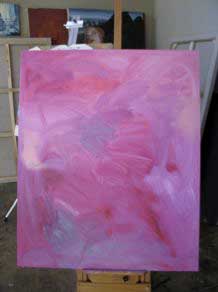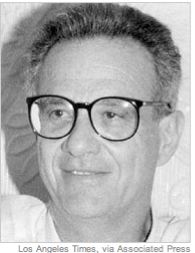I made a great big canvas. For three weeks it sat in the center of the studio like Jack's massive desk in The Shining. No matter how many "painting miles" I've earned, there's really nothing more terrifying. Of course, I have some ideas, a subject, a palette in my mind. Several in fact. But I've encircled it, ignored it, worked on smaller paintings instead. Finally, today, I took six different shades of pink. Some cadmium red light, rose and violet, and I just attacked it. It's okay, I wasn't totally committed because I knew it was just the ground of probably ten layers that will live above it. But it was a start.

Like Kubler-Ross' five stages of death--Denial, Anger, Bargaining, Depression, Acceptance--I divide the creative process into eight stages. The first two are (1) Vision and (2) Hope. I don't care who you are or what the medium, whether writer, filmmaker, musician, or lithographer or lawyer, or postman, every person goes through these two phases when they get struck by an idea. Vision tends to come in a flash. Then Hope makes the heart swoon and the mind swell around it. Being a great daydreamer helps. Everyone is an artist.
But the difference between artists who create and artists who walk around pregnant with ideas is the third stage which I call (3) Diving In. That's the scary one. That's the one I had to deal with in the studio with the pink paint. My father is a surgeon and I used to watch him operate a lot when I was a kid. I'll never forget that singular moment, in the theatre of the operating room, when he had to press the scalpel into the flesh and make the cut. That's a surgeon's "Diving In". Mine just had less blood.
The next four stages are (4) Excitement (5) Suspicion (6) Clarity and (7) Obsession. Often I bounce between Excitement and Suspicion--suspicion that perhaps my instincts are wrong; that I'm heading in the wrong direction -- (Anxiety! Despair!) Finally I move on to Clarity. Clarity, like Vision, often happens in a moment-- when the sky opens and I can hear the angels sing. Then my favorite part is the tireless consuming fever of Obsession, the life force of every artist. The entire sequence can tend to form an infinite loop. Some artists just barely or never get out of this mobius strip, like the San Francisco Female Painter (whose name I can't remember) who added paint to the same canvas her entire career with a nervous pack of cigarettes until she died. Although Schubert's Unfinished Symphony was supposedly actually finished, James Joyce apparently couldn't help but to add pages every time he edited Ulysess and it almost never made it to the publisher. Then there's the perhaps sixty percent of you, dear readers, who have an unfinished draft of the next Great American Novel rotting in your desk drawer or hard drive.
 Jerry Belson Photo credit: Los Angeles Times, Associated Press
Jerry Belson Photo credit: Los Angeles Times, Associated Press
A year ago, I attended the funeral of the well-known and beloved TV Writer Jerry Belson ("The Dick Van Dyke Show," "The Odd Couple", etc.) whose wife Jo Ann is also an artist. During the eulogy by one of his writer friends, he said that whenever he had massive writer's block he would call Jerry, exasperated. Jerry would say, "Just lay down shit, babe. Just lay down shit." What a liberating mantra! Don't worry if it sucks. Don't worry about ruining it. Just lay it down and get on with it. Making art is risky. Making art takes work. The mortar of all these stages is Discipline and Faith. Then listen, feel and see what's going on. All art works, are living organisms -- if you get out of the way they'll tell you the next move.
The last stage is (8) Resolution. Very elusive. The composer Aaron Copland said he didn't finish compositions so much as abandon them. When it's finally over, it feels like a whole relationship has ended. And then the anticipated rush of doing it all over begins again.

First Person Artist is a weekly column by painter Kimberly Brooks in which she provides commentary on art and process and showcases artists' work from around the world.
